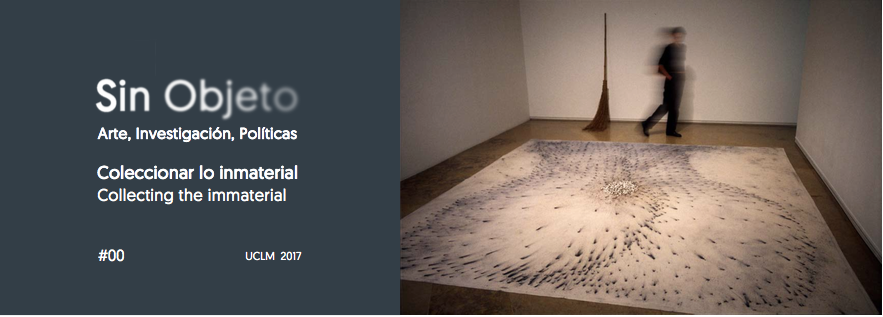Documenting dilemmas. On the relevance of ethically ambiguous cases
Main Article Content
Abstract
Article Details
Todos los artículos de la revista, están sujetos a una licencia Creative Commons del tipo Reconocimiento - NoComercial - Sin Obra Derivada
References
Barker, R. y Bracker, A. (2005, Autumn). Beuys is Dead: Long Live Beuys! Characterising Volition, Longevity, and Decision-Making in the Work of Joseph Beuys. Tate Papers, (4) Autumn 2005. Recuperado de: http://www.tate.org.uk/research/tateresearch/tatepapers/05autumn/barker.htm
Beerkens, L., Hummelen, I. y Sillé, D. (1999). Reconstruction of a Moving Life. En I. Hummelen y D. Sillé (Eds.), Modern Art: Who Cares? An Interdisciplinary Research Project and an International Symposium on the Conservation of Modern and Contemporary Art (pp. 23-41). Amsterdam: The Foundation for the Conservation of Modern Art and the Netherlands Institute for Cultural Heritage.
Bek, R. (2011). Between Ephemeral and Material – Documentation and Preservation of technology-Based Works of Art. En T. Scholte y G. Wharton (Eds.), Inside Installations. Theory and Practice in the Care of Complex Artworks (pp. 205-215). Amsterdam: Amsterdam University Press.
Bosma, J. (2011). Nettitudes. Let’s Talk Net Art. Rotterdam: NAi Publishers.
Bracht, E. et. al. (2001). The Restoration of Barnett Newman’s Cathedra. SMA Cahiers 24 (pp. 66-102). Amsterdam: Stedelijk Museum Amsterdam.
Brody, B. A. (2003). Taking Issue: Pluralism and Casuistry in Bioethics. Washington DC: Georgetown University Press.
Buskirk, M. (2003).The contingent object of contemporary art. London, Cambridge, MA: The MIT Press.
Cherry, M. y Smith Iltis, A. (2007). Pluralistic Casuistry: Moral Arguments, Economic Realities, and Political Theory. Dordrecht: Springer.
Clavir, M. (1998). The Social and Historic Construction of Professional Values in Conservation. Studies in Conservation 43 (1), 1-8.
Groot, E de, Guldemond, J. y Kleizen, A. (2007). Summary of the case study Notion Motion 2005. Inside Installations: Preservation and Presentation of Installation Art. Recuperado de: www.inside-installations.org
Gross, B. (2012). Order and Disorder: Where Every Wall is a Door. En B. Gross, Sol LeWitt (pp. 10-29). Metz: Éditions du Centre Pompidou-Metz.
Groys, B. (1996, March). The Restoration of Destruction. Witte de With Cahiers (4), 155-160.
Heydenreich, G. (2011). Documentation of Change – Change of Documentation. En T. Scholte y G. Wharton (Eds.), Inside Installations. Theory and Practice in the Care of Complex Artworks (pp. 155-171). Amsterdam: Amsterdam University Press.
Hummelen, I. (1992). Who's afraid of Red, Yellow and Blue III, Barnett Newman. Zeitschrift für Kunsttechnologie und Konservierung 6(2), 215-222.
Hummelen, I. y Scholte, T. (2006). Capturing the Ephemeral and Unfinished. Archiving and documentation as conservation strategies of transient (as transfinite) contemporary art. Technè, (24), 5-11.
Irvin, S. (2006). Museums and the Shaping of Contemporary Artworks. Museum Management and Curatorship, 21(2), 143–156.
Jonson, A.R. y Toulmin, S. (1988). The Abuse of Casuistry. A History of Moral Reasoning. Berkeley, Los Angeles y Londres: University of California Press.
Laurenson, P. (2006, Autumn). Authenticity, Change and Loss in the Conservation of Time-Based Media Installations. Tate Papers, (6). Recuperado de: http://www.tate.org.uk/research/tateresearch/tatepapers/06autumn/laurenson.htm
Lewitt, S. (1967). Paragraphs on Conceptual Art. Artforum, 5(10), 79-83.
Lovatt, A. (2010). Ideas in Transmission: LeWitt’s Wall Drawings and the Question of Medium. Tate Papers, (14). Recuperado de: www.tate.org.uk/research/ publications/tate-papers/ideas-...
Matyssek, A. (2012). Überleben und Restaurierung. Barnett Newmans Who’s Afraid of Red, Yellow and Blue III und Cathedra. En P. Geimer y M. Hagner (Eds.), Nachleben und Rekonstruktion. Vergangenheit im Bild (pp. 49-69). München: Wilhelm Fink Verlag.
Muñoz Viñas, S. (2005). Contemporary Theory of Conservation. Amsterdam: Elsevier Butterworth-Heinemann.
Nordgren, A. (2001). Responsible Genetics. The Moral Responsibility of Geneticists for the Consequences of Human Genetics Research. Philosophy and Medicine (Vol 70). Dordrecht, Boston & London: Kluwer Academic Publishers.
Ramade, B. (2012, été). Sol LeWitt: Les coulisses du montage. L’oeil (648), 66-71.
Real, W.A. (2001). Toward guidelines for practice in the preservation and documentation of technology-based installation art. Journal of the American Institute for Conservation 40(3), 211-31.
Roberts, V. (2012). Like a musical score: Variability and Multiplicity in Sol LeWitt’s 1970 Wall Drawings. Master Drawings 50(2), 193-211.
Sillé, D. (1999). Introduction to the project. En I. Hummeleny D. Sillé (Eds.), Modern Art: Who Cares? An Interdisciplinary Research Project and an International Symposium on the Conservation of Modern and Contemporary Art (pp. 14-19). Amsterdam: The Foundation for the Conservation of Modern Art and the Netherlands Institute for Cultural Heritage.
Scholte, T. (2011). Introduction. En T. Scholte y G. Wharton (Eds.), Inside Installations. Theory and Practice in the Care of Complex Artworks (pp. 11-20). Amsterdam: Amsterdam University Press.
Scholte, T. y Brake-Baldock, K. te (2007). Introduction. En Inside Installations. Preservation and Presentation of Installation Art. Recuperado de: http://www.sbmk.nl/uploads/inside-installations-kl.pdf
Swierstra, T. (2002). Ethiek op zijn plaats zetten. Normatieve ethiek als empirische filosofie. Krisis – Tijdschrift voor empirische filosofie 3(3), 18-38.
Van Saaze, V. (2013a). Installation Art and the Museum. Presentation and Conservation of Changing Artworks. Amsterdam: Amsterdam University Press.
Van Saaze, V. (2013b). Case Study: No Ghost Just a Shell by Pierre Huyghe, Philippe Parreno, and Many Others. En J. Noordegraaf, C.A. Saba, B. Le Maître y V. Hediger (Eds.), Preserving and Exhibiting Media Art. Challenges and Perspectives (pp. 170-175). Amsterdam: Amsterdam University Press.
Van Wegen, R. (1999). Between Fetish and Score: The Position of the Curator of Contemporary Art. En J. Hummelen y D. Sillé (Eds.), Modern Art: Who Cares? An Interdisciplinary Research Project and an International Symposium on the Conservation of Modern and Contemporary Art (pp. 201-209). Amsterdam: The Foundation for the Conservation of Modern Art and the Netherlands Institute for Cultural Heritage.
Villers, C. (2004). Post Minimal Intervention. The Conservator 28(1), 3-10.
Wharton, G. (2005). The Challenges of Conserving Contemporary Art. En B. Altshuler. Collecting the New: Museums and Contemporary Art (pp. 163-178). Princeton: Princeton University Press.
Wharton, G. y Molotch, H. (2009). The Challenge of Installation Art. En A. Richmond y A. Bracker. Conservation: Principles, Dilemmas, and Uncomfortable Truths (pp. 210-222). Amsterdam: Elsevier/ Butterworth-Heinemann.
Wyer, C. (2006). Restoration Theory Applied to Installation Art. Beitrage zur Erhaltung von Kunst und Kulturgut, Verband der Restoratoren 2006(2), 40-48.
